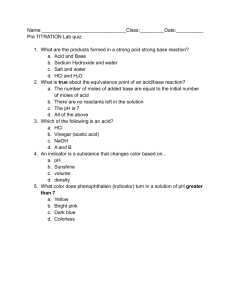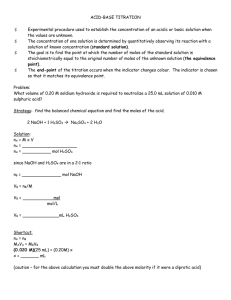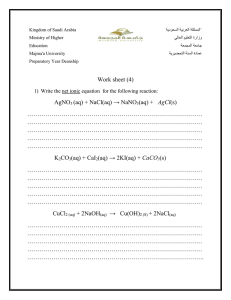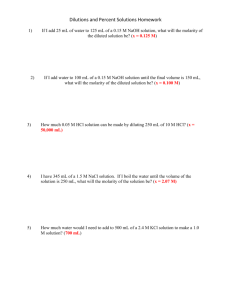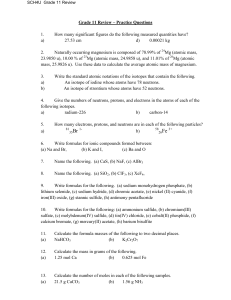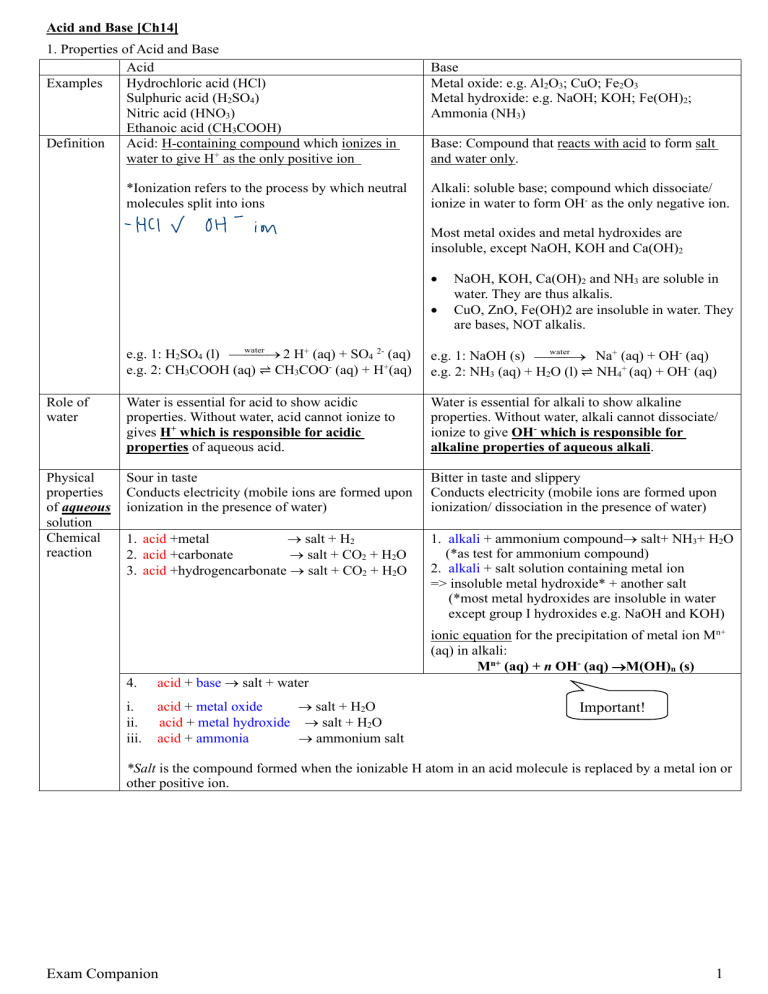
Acid and Base [Ch14] 1. Properties of Acid and Base Acid Examples Hydrochloric acid (HCl) Sulphuric acid (H2SO4) Nitric acid (HNO3) Ethanoic acid (CH3COOH) Definition Acid: H-containing compound which ionizes in water to give H+ as the only positive ion *Ionization refers to the process by which neutral molecules split into ions - HCI V OH im Base Metal oxide: e.g. Al2O3; CuO; Fe2O3 Metal hydroxide: e.g. NaOH; KOH; Fe(OH)2; Ammonia (NH3) Base: Compound that reacts with acid to form salt and water only. Alkali: soluble base; compound which dissociate/ ionize in water to form OH- as the only negative ion. Most metal oxides and metal hydroxides are insoluble, except NaOH, KOH and Ca(OH)2 • • NaOH, KOH, Ca(OH)2 and NH3 are soluble in water. They are thus alkalis. CuO, ZnO, Fe(OH)2 are insoluble in water. They are bases, NOT alkalis. e.g. 1: H2SO4 (l) ⎯water ⎯ ⎯→ 2 H+ (aq) + SO4 2- (aq) e.g. 2: CH3COOH (aq) ⇌ CH3COO- (aq) + H+(aq) e.g. 1: NaOH (s) ⎯water ⎯ ⎯→ Na+ (aq) + OH- (aq) e.g. 2: NH3 (aq) + H2O (l) ⇌ NH4+ (aq) + OH- (aq) Role of water Water is essential for acid to show acidic properties. Without water, acid cannot ionize to gives H+ which is responsible for acidic properties of aqueous acid. Water is essential for alkali to show alkaline properties. Without water, alkali cannot dissociate/ ionize to give OH- which is responsible for alkaline properties of aqueous alkali. Physical properties of aqueous solution Chemical reaction Sour in taste Conducts electricity (mobile ions are formed upon ionization in the presence of water) Bitter in taste and slippery Conducts electricity (mobile ions are formed upon ionization/ dissociation in the presence of water) 1. acid +metal → salt + H2 2. acid +carbonate → salt + CO2 + H2O 3. acid +hydrogencarbonate → salt + CO2 + H2O 1. alkali + ammonium compound→ salt+ NH3+ H2O (*as test for ammonium compound) 2. alkali + salt solution containing metal ion => insoluble metal hydroxide* + another salt (*most metal hydroxides are insoluble in water except group I hydroxides e.g. NaOH and KOH) ionic equation for the precipitation of metal ion Mn+ (aq) in alkali: Mn+ (aq) + n OH- (aq) →M(OH)n (s) 4. acid + base → salt + water i. ii. iii. acid + metal oxide → salt + H2O acid + metal hydroxide → salt + H2O acid + ammonia → ammonium salt Important! *Salt is the compound formed when the ionizable H atom in an acid molecule is replaced by a metal ion or other positive ion. Exam Companion 1 2. Solubility of metal hydroxide in excess NaOH and NH3 Metal ion Mg2+ (aq) Al3+ (aq) Zn2+ (aq) Pb2+ (aq) Fe2+ (aq) Fe3+ (aq) Cu2+ (aq) Ag+ (aq) Ionic equation to show precipitation with NaOH (aq) / NH3 (aq) Mg2+ (aq) + 2OH- (aq) colourless Al3+ (aq) + 3 OH- (aq) colourless Zn2+ (aq) + 2OH- (aq) colourless Pb2+ (aq) + 2OH- (aq) colourless Fe2+ (aq) + 2OH- (aq) green Fe3+ (aq) + 3 OH- (aq) yellow Cu2+ (aq) + 2OH- (aq) blue 2 Ag+ (aq) + 2OH- (aq) colourless Colour of Precipitate Formed White → Mg(OH)2 (s) white ppt. → Al(OH)3 (s) white ppt. → Zn(OH)2 (s) white ppt. → Pb(OH)2 (s) white ppt. → Fe(OH)2 (s) dirty green ppt. → Fe(OH)3 (s) reddish brown ppt. → Cu(OH)2 (s) blue ppt. → Ag2O (s) + H2O (l) brown ppt. * Ag+ (aq) ions do not form AgOH(s) with OH − White White White Dirty green Reddish brown Blue Brown Action of excess NaOH(aq) Action of excess NH3(aq) insoluble insoluble ppt. redissolves to form insoluble colourless solution ppt. redissolves to form ppt. redissolves to form colourless solution colourless solution ppt. redissolves to form insoluble colourless solution insoluble insoluble insoluble insoluble ppt. redissolves to form deep blue solution ppt. redissolves to form colourless solution insoluble insoluble (aq) because AgOH does not exist; Ag2O is formed instead. Addition of NaOH (aq) / NH3 (aq) is often used in qualitative analysis to identify certain metal ions. Concentration of Solution [Ch15] Concentration of solution = amount of solute Note: volume of solution 1 dm = 10 cm (1 dm)3 = (10 cm)3 1 dm3 = 1000 cm3 ⚫ The concentration of a solution is usually expressed in: (a) g cm-3 (b) g dm-3 (c) mol dm-3 (or M) ⚫ Molarity of a solution refers to its concentration expressed as number of moles of solute per dm3 of the solution. The unit of molarity is mol dm-3 or M. Molarity of a solution (mol dm-3 or M ) = no. of moles of solute (mol) volume of solution (dm3) By rearrangement, No. of moles of solute (mol) = = Molarity of solution (mol dm-3) Volume of solution (dm3) M V Example 1 15.0 g of NaOH is dissolved in 250 cm3 of water. Calculate the molarity of the NaOH solution. [relative atomic masses: H – 1.0; O – 16.0; Na – 23.0] Example 2 Find the mass of sodium carbonate (in g) in 50 cm3 of 3.5 M Na2CO3 (aq). [relative atomic masses: C – 12.0; O – 16.0; Na – 23.0] Strategy: Express concentration in mol dm-3 Concentration 15 g = 250 cm3 = 15 mol 23+16+1 250 dm3 1000 = 1.5 mol dm-3 Exam Companion Carry out unit conversion, 1 at a time No. of moles of Na2CO3 50 =(1000) (3.5) = 0.175 Mass of Na2CO3 = 0.175 x (23x2+12+16x3) = 18.55 g No. of moles of solute = MV Volume must be in dm3 2 Example 3 A concentrated sulphuric acid solution contains 98% by mass of sulphuric acid. Density of this concentrated sulphuric acid is 1.83 g cm-3.Calculate the molarity of the sulphuric acid solution. [relative atomic masses: H – 1.0; O – 16.0; S – 32.1] Strategy: Mass of 1 dm3 of solution 1.83 g = x 1000 dm3 1 cm3 = 1830 g A solution is made of solute (H2SO4) and solvent (water). The solution contains 98% by mass of H2SO4 means 100 g of the solution has 98 g of H2SO4 in it. mass of 𝐬𝐨𝐥𝐮𝐭𝐢𝐨𝐧 Density of solution = volume of solution Density = 1.83 g cm-3 means 1 cm3 of solution has a mass of 1.83 g (which is made up of water and H2SO4) Mass of H2SO4 in 1 dm3 of solution = 1830 x 98% = 1793.4 g Molarity of H2SO4 (aq) 1793.4 =2+32.1+16 (4) = 18.2 M Molarity of solution no.of moles of 𝐬𝐨𝐥𝐮𝐭𝐞 = 𝑣𝑜𝑙𝑢𝑚𝑒 𝑜𝑓 𝑠𝑜𝑙𝑢𝑡𝑖𝑜𝑛 (𝑖𝑛 𝑑𝑚3 ) Dilution No. of moles of solute before dilution = No. of moles of solute after dilution M1V1 (before dilution) = M2V2 (after dilution) Example 1 Example 2 Calculate the molarity of the diluted acid solution when 600 cm3 of water is added to 400 cm3 of 8M of hydrochloric acid solution. M1V1 = M2V2 400 600+400 8 (1000) = M2 ( 1000 ) V2 refers to the total volume after M2 = 3.2 M mixing. Find the volume of water added to 50.0 cm3 of 1.6 M nitric acid, in order to prepare 0.8M nitric acid. M1V1 = M2V2 50 50+V 1.6 ( ) = 0.8 ( ) 1000 1000 3 V = 50 cm V refers to volume of water added Example 3 A mixture is prepared by mixing 50.0 cm3 0.1 M Fe2(SO4 )3 (aq) and 50.0 cm3 0.2 M FeSO4 (aq). Calculate the molarity of the SO42- in the resulting mixture. Molarity of the SO42= = no.of moles of SO42− (mol) volume of solution (dm3 ) (0.05x 0.1 x 3)+(0.05x0.2) (0.05+0.05) 1 mole of Fe2(SO4)3 contains 3 moles of SO42- 1 mole of FeSO4 contains 1 mole of SO42- = 0.25 M ➢ ➢ ➢ ➢ Hazard of acids and alkalis : corrosive Safety precautions: wear safety goggles, rubber gloves and laboratory gown A large amount of heat is released when strong acids, like H2SO4 and HCl, are mixed with water. In the dilution of acids, the small amount of concentrated acid should be added into large amount of water with constant stirring. Exam Companion 3 pH and indicators [Ch 16] Acidic sol. Alkaline sol Neutral sol conc. of H + > conc. of H + < conc. of H + = Methyl orange Phenolphthalein pH = - log [H+ (aq)] [H+ (aq)] = 10 − pH conc. of OH − conc. of OH − conc. of OH − In acidic medium Red Colourless pH at 25oC <7 >7 =7 In alkaline medium Yellow Pink where [H+(aq)] is concentration of H+ (aq) in mol dm-3 (or M) minus pH Example 1 Calculate the pH of 0.3 M HCl (aq) Solution: pH = - log [H+ (aq)] = - log (0.3) = 0.52 Example 2 Calculate [H (aq)] of a solution of pH = 4.3 Solution [H+ (aq)] = 10− pH = 10- 4.3 = 5.01 x 10-5 M + Strength of acids/ alkalis [Ch 17] ➢ Acids and alkalis can be classified as strong or weak based on their extent of ionization. ➢ Acids and alkalis which completely ionize are strong. ➢ Acids and alkalis which partially/ slightly ionize are weak. Strong acid HCl, HNO3, H2SO4 Weak acid CH3COOH and other carboxylic acid Strong alkali NaOH, KOH, Ca(OH)2 Weak alkali NH3 Ionization in water: CH3COOH (aq) ⇌ CH3COO- (aq) + H+ (aq) ⇌ means the reaction is incomplete Ionization in water: NH3 (aq) + H2O (l) ⇌ NH3 (aq) + H2O (l) pH of solution of acid depends on the following factors: ➢ basicity of acid (maximum no. of H+ ions formed from 1 acid molecule upon ionization) ➢ concentration of acid ➢ strength of acid To compare the strength of acids, we can compare the following provided that the acids used are of the same basicity and the solutions used are of the same molarity. ➢ Electrical conductivity [which depends on concentration of mobile ions] ➢ pH [which depends on the concentration of H+(aq)] ➢ Rate of reaction with metal [depends on concentration of H+(aq)] Strength of alkalis can also be studied similarly by comparing electrical conductivity and pH. Exam Companion 4 Neutralization [Ch 18] ➢ Acid react with base to form salt and water ONLY. This reaction is known as neutralization. ➢ Neutralization is the combination of hydrogen ion and hydroxide ion (or oxide ion) to form water molecules. ➢ Neutralization reaction is exothermic. ➢ Applications of neutralization: e.g. treatment of soil/ industrial waste/ indigestion; cleaning action of toothpaste reluhenf Solubilities of Some Common Compounds in Water Soluble Insoluble 1. All hydrogencarbonates* 2. All sodium salts 3. All potassium salts 4. All ammonium salts SPANISH 5. All nitrates 6. All sulphates, except SH 7. All halides (e.g.Cl, Br, I), except 8. Sodium carbonate Potassium carbonate Ammonium carbonate 9. Sodium hydroxide Potassium hydroxide Calcium hydroxide (slightly soluble) 10. Sodium oxide Potassium oxide Calcium oxide AgX, BaSO4, CaSO4, PbSO4, PbX2 ABCPP XSSSX All other common • carbonates • hydroxides • oxides Alkalis: soluble bases SH [Note: when dissolved in water, they react with water immediately to form soluble metal hydroxide] *For hydrogencarbonates, only those of group 1 exist in solid form, the others are too unstable and can only exist in solution forms Common insoluble compounds 1. ABCPP XSSSX 2. CHOO (carbonates, hydroxides and oxides) except SPA (sodium, potassium and ammonium) [Note: CaO and Ca(OH)2 are soluble] [Note:inCaO and Ca(OH) soluble] 2 arein Precipitation reaction: reaction which two substances aqueous form react to form an insoluble product. precipitation of insoluble ionic compounds: solution containing the cation + solution containing the anion e.g. Fe(NO3)2 (aq) + 2NaOH (aq) → Fe(OH)2 (s) + NaNO3 (aq) e.g. KCl (aq) + AgNO3 (aq) → AgCl (s) + KNO3 (aq) e.g. HCl (aq) + AgNO3 (aq) → AgCl (s) + HNO3 (aq) Exam Companion 5 8. The following shows a flow chart that can help us to decide how to prepare a particular salt. Their corresponding metals, bases and carbonates are all soluble. For salts except those of Na+, K+, NH4+ For salts of Na+, K+, NH4+ Acid + excess metal/ excess insoluble/ base/ excess insoluble carbonate Acid + Mixing two solutions alkali/ (one with the cation; carbonate the other with the anion) to get a (via Titration) precipitate i.e. precipitation* (Remove insoluble reactant) (Remove soluble impurities) IMPORTANT! [Reminders: students are expected to suggest reagents needed to prepare a salt and describe how to purify the salt prepared from the reaction mixture.] Exam Companion 6 Volumetric Analysis [Ch19] Definition: Standard solution refers to solution of accurately known concentration important Standard solution can be prepared by (i) dissolving a known amount of solute in known volume of water which usually involves the following stages: 1. weigh the required mass of solute accurately using electronic balance 2. dissolve the solute in water in beaker 3. transfer the solution into a volumetric flask with the help of filter funnel and glass rod 4. after rinsing, transfer all washings into the volumetric flask 5. fill the volumetric flask up to the graduation mark with distilled water 6. stopper the flask, invert it and swirl (ii) diluting a concentrated solution of known molarity which usually involves the following stages: 1. transfer the required volume of the solution using pipette (or burette) into a volumetric flask 2. make up the solution to the graduation mark by adding distilled water 3. stopper the flask, invert it and swirl graduation mark pipette Stock solution of known concentration [Reminders: students are expected to state what should be used to rinse the apparatus with] Exam Companion 7 Titration aA+bB ⎯ ⎯→ c C + d D no. of particles of A Mass of A molar mass no. of particles of B Avogadro's no. no. of moles of A molarity Mass of B Avogadro's no. molar mass no. of moles of B mole ratio molarity no. of particles no. of moles = Avogadro' s number Volume of Solution A Volume of Solution B mass (g) no.of moles = molar mass (g mol -1 ) molarity (M) = no. of moles of solute (mol) volume of solution (dm3 ) Strategy: 1. Write a balanced equation. 2. Write down the given data underneath the corresponding reactants/products. 3. Identify the ‘given’ and the ‘target’ 4. Work out the steps to be taken to calculate the unknown from known quantities. Usual steps involved: (i) find no. of moles of the “given“ (e.g. A) (ii) use the mole ratio to find the no. of moles of the “target” (e.g. B) (iii) calculate what the question is asking for. This method works in most titration problems. !!! Be particularly careful about questions which involve dilution/ extraction of part of the solution for titration. Example 1 50.0 cm3 of a sample of sulphuric acid were diluted to 250.0 cm3. 25.0 cm3 of the diluted sulphuric acid required 50.0 cm3 0.160 M sodium hydroxide solution for complete neutralization. Calculate the molarity of sulphuric acid in the original sample. 0.160 M NaOH (aq) Stage 1 Stage 2 dilution Extract part of the solution ( 1/10) for titration 50.00 cm3 H2SO4 250.00 cm3 diluted H2SO4 no. of moles of solute the same; concentration becomes 1/10 of the original Stage 1: H2SO4 (aq) → H2SO4 (aq) 50.00 cm3 250.00 cm3 ?M diluted Solute particle 25.00 cm3 diluted H2SO4 no. of moles of solute becomes 1/10 of the original; same concentration; Stage 2: part of the solution ( 1/ 10) for titration Extract H2SO4 (aq) + 2 NaOH (aq) →Na2SO4(aq)+ 2 H2O (l) 25.00 cm3 19.50 cm3 diluted 0.160 M No. of moles of NaOH = 0.16 x 0.0195 = 3.12 x 10-3 No. of moles of H2SO4 in 25.0 cm3 of the diluted acid = 3.12 x 10-3 x 1 2 = 1.56 x 10-3 No. of moles of H2SO4 in 250.0 cm3 of the diluted acid = 1.56 x 10-3 x 10 = 0.0156 Molarity of H2SO4 in the original acid = 0.015725 / 0.05 = 0.312 M Exam Companion 8 Example 2 2.98 g of an impure sample of ethanedioic acid, of chemical formula H2C2O4• 2H2O, are dissolved in water. The solution required 20.0 cm3 of 2.00 M potassium hydroxide solution for complete neutralization. Assuming that the impurity in the sample does not react with potassium hydroxide, calculate the percentage purity of H2C2O4• 2H2O in the sample. (Relative atomic mass: C=12.0, H= 1.0, O=16.0) H2C2O4• 2H2O (s) → H2C2O4 (aq) 2.98 g H2C2O4 + 2 KOH → K2C2O4 + 2 H2O 20.0 cm3 2.00 M % purity of H2C2O4• 2H2O = mass of H2 C2 O4 • 2H2 O mass of the whole sample x 100% No. of mole of KOH = 0.05 (2) = 0.04 No. of moles of H2C2O4 = 0.04 / 2 = 0.02 No. of mole of H2C2O4• 2H2O = 0.02 (since 1 mole of H2C2O4• 2H2O forms 1 mole of H2C2O4) Mass of H2C2O4• 2H2O = 0.02 x [2+12 x 2 + 16 x4 + 2 x (2+16)] = 2.52 g % purity of H2C2O4• 2H2O =(2.52 / 2.98) x 100% = 84.6 % Example 3 X is an acid. 25.0 cm3 of 0.20 M solution X requires 30.0 cm3 of 0.50 M sodium hydroxide solution for complete neutralisation. Determine the basicity of acid. Let the basicity of acid be n. acid X + n NaOH => salt + water Strategy: find the mole ratio of acid and alkali no. of moles of acid X = 0.025 x 0.20 = 0.005 no. of moles of NaOH = 0.03 x 0.50 = 0.015 Acid X and NaOH react in the ratio of 1: n 1 0.005 = 0.015 n n=3 Back Titraiton The technique of back titration is used when the mass of a solid sample to be analysed is insoluble in water. Analogy: Consider the following scenario and find out how much a lollipop cost. Ans: ____________________ $40 Mary had cash $100 She bought 2 lollipops of unknown price She then used all the remaining cash to buy two ice-cream cones, which cost $10 each. In shop 1 In shop 2 Exam Companion 9 Back titration usually involves the following stages: Acid A remained is then titrated with B (known amount) acid A + solid X (known excess amount) (unknown amount) (Reaction 1) (Reaction 2 – Titration) To be determined known excess amount of A Reaction 1 Amount of A reacted with X (of unknown amount) in Reaction 1 Reaction 2 Amount of A reacted with B (of known amount) in Reaction 2 Strategy: 1. Find no. of moles of unreacted A after reaction 1. (based on titration results). 2. Find no. of moles of A reacted with X. (original amount of A - remaining amount of A) 3. Find no. of moles of X. (based on reaction 1) [Example 1] – determine the number of moles of CaCO3 in a limestone sample ➢ A limestone sample was fully dissolved in 0.04 moles of HCl. [Reaction 1] ➢ After the reaction, the acid solution remained was then titrated with 1.0 M NaOH. It was found that 10.0 cm3 NaOH was required to reach end point. [Reaction 2] ➢ Determine the number of moles of CaCO3 in the limestone sample. Reaction 1 Reaction 2 10.0 cm3 1.0 M NaOH 0.04 moles of HCl (in excess) Unreacted HCl limestone sample 0.04 moles of HCl Reaction 1 Reacted with limestone Reaction 2 Reacted with NaOH Strategy: 1. Write balanced equations for the reactions involved. Reaction 1: CaCO3 + 2HCl → CaCl2 + CO2 + H2O Reaction 2: (Titration) HCl + NaOH → NaCl + H2O 2. Calculate (i) no. of moles of HCl originally present before reaction 1 = 0.04 (ii) no. of moles of HCl remained after reaction 1 based on the titration result = (1) (10/1000) = 0.01 (iii) no. of moles of HCl used up during reaction 1 = 0.04 – 0.01 = 0.03 (iv) no. of moles of CaCO3 present in the solid by considering coefficient ratio of reaction 1 = 0.03 / 2 = 0.015 Exam Companion 10 [Example 2] – determine the mass of insoluble CaCO3 by back titration 50.0 cm3 of 2.0 M HCl(aq) was added to 5.50 g of an impure sample of CaCO3. After the reaction, the remaining acid in the reaction mixture was then titrated with 1.0 M NaOH(aq). It was found that 22.0 cm3 of NaOH(aq) was required to reach the end point. Determine the mass of CaCO3 in the sample. [Molar mass of CaCO3 = 100.1 g] back-titrate with standard NaOH(aq) excess original no. of moles of HCl 22.0 cm3 1.0M NaOH (aq) NaOH remaining HCl HCl reacted C remaining HCl determine C amount of CaCO3 Strategy: 1. Write down 2 balanced equations for the reactions involved. 2. Find no. of moles 1M, 22 cm3 of remaining HCl (back titration, Reaction 2) NaOH Reaction 1: Reaction 2: CaCO3 + 2HCl → CaCl2 + CO2 + H2O HCl + NaOH → NaCl + H2O (titration) remaining Refer to reaction 2, in titration no. of moles of remaining HCl = no. of moles of NaOH = 1 x 22 x 10-3 remaining HCl C 3. Find no. of moles of HCl reacted with CaCO3 (by subtracting no. of moles of remaining HCl from the No. of moles of HCl reacted with CaCO3 = 2 x 50 x 10-3 (original) - 1 x 22 x 10-3 (remaining) = 0.078 original no. of moles of HCl) 4. Find no. of moles of CaCO3 (which can be determined from no. of moles Refer to reaction 1, No. of moles of CaCO3 = ½ x 0.078 of HCl reacted, Reaction 1) 5. Find the required quantity of CaCO3 Mass of CaCO3 = ½ x 0.078 x 100.1 = 3.904 g (e.g. mass) Exam Companion 11
